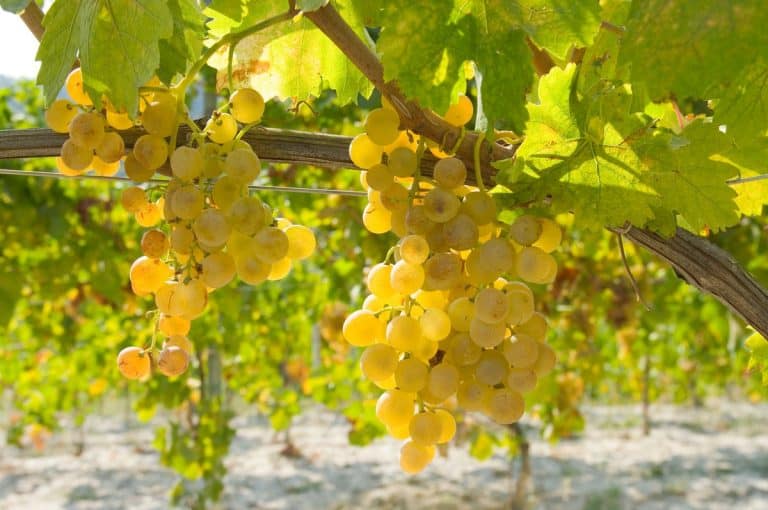Despite Piedmont being renowned for its great reds, particularly Barolo and Barbaresco, it also boasts a good ampelographic heritage of indigenous white berry varieties. One of the most interesting is undoubtedly Erbaluce, a grape native to the pre-alpine Piedmont area, mainly found in Canavese and around Lake Viverone. It's a territory of gentle morainic hills, shaping the contours of a natural amphitheater of glacial origin. The soils are predominantly composed of deposits from the ancient Alpine glacier. These are very draining soils, rich in pebbles and minerals, particularly suitable for quality viticulture.

Viverone Lake
Erbaluce is an extremely flexible and versatile grape variety, capable of producing a range of very different wines. Indeed, it demonstrates elegant versatility, ranging from classic method sparkling wines to passitos, passing through still wines and late harvests. Its name seems to derive from the Latin expression "Alba Lux" and fanciful legends have been created about its mysterious origins, which still form part of the culture and tradition of these lands. According to the ancient customs of the region, Erbaluce is generally grown using the pergola canavesana system, but there are also more recent Guyot systems. It is a variety that produces medium-sized clusters with a slightly elongated shape. When the berries reach full ripeness, they take on a beautiful golden yellow color with bright amber reflections. As we mentioned above, it is one of the few grape varieties that manages to cover the production of all types of wine, always with excellent results. From early harvest for sparkling wine bases to drying in the fruit cellar for dessert wines, Erbaluce offers surprising and fascinating wines. It is a variety that maintains high acidity even at the peak of ripeness, with an aromatic profile that expresses elegant and fresh floral and fruity aromas. All characteristics that allow for wines with excellent balance between sugars, fruit, and acidity.
Classic Method sparkling wines are fresh and refined, perfect with appetizers or delicate fish dishes. Still whites stand out for their finesse, elegance, and surprising longevity. They pair well with vegetable-based preparations or seafood menus. Late harvests and passitos stand out for their pleasant freshness, which counterbalances the residual sweetness, giving extraordinary drinkability. They are ideal companions for a platter of aged and blue cheeses or dry pastries.
The best Erbaluce di Caluso
Here are the Erbaluce di Caluso wines that received the Due Bicchieri Rossi, having reached the final during the tastings for the Gambero Rosso 2024 Wine Guide.
The Erbaluce di Caluso Anima Dannata 2020 is of sustained elegance, with hints of fresh herbs and ferns on a background of flintstone, and a substantial palate, voluminous, yet remarkably refined, with a long and persistent finish. It seemed like a game at first, a game that over time became more serious. Thus, five friends, coordinated by Alessandro Comotto, found themselves holding one of the most dynamic realities in Canavese. The founders' intention, however, remains the one that set things in motion: to interpret the territory to the best of their ability, gathering the viticultural legacy of their grandparents without forgoing the opportunities offered by new cellar techniques. Erbaluce is the undisputed protagonist of a rather varied range of wines that among its expressions also includes labels from Barbera, Freisa, Vespolina, and Nebbiolo grapes.
Always at the top of the denomination is the Erbaluce di Caluso La Rustìa. The 2022 version is of great complexity with its aromas of white fruit and ginger, accompanied by vegetal nuances, while the palate is harmonious and powerful, with a long finish of remarkable sapidity. It is the morainic hills between Mazzé and Caluso that provide the backdrop for Gian Luigi Orsolani's wine adventure. "Gigi" is one of the most convinced interpreters of the territory, with a rather important heritage to protect if we consider that the first bottles of Erbaluce proposed by the Orsolani date back to 1894. Before it was fashionable to produce classic method with any grape variety, successful experiments were already being carried out here with sparkling wine, not to mention the rare versions of Passito from Erbaluce, wines with charm and character but almost impossible to find due to their extremely limited production.
The Erbaluce di Caluso Le Chiusure 2021 has intense notes of white fruit on a mineral background and is characterized by a very broad palate, rich in pulp, with a salty and very long finish. Also beautiful is the other Erbaluce di Caluso 2021, the Tredicimesi, of remarkable complexity in its slightly peely and fresh herb notes, with a dynamic palate and a bittering finish. It is useless to hide it: when the winemaker cultivates a passion for wine, the product succeeds. But cultivating passion does not just mean working in the vineyard and cellar; of course, that is necessary, but culture really makes the difference. And culture certainly does not lack in Camillo Favaro, at the helm of the company created by his father Benito. A knowledge of the world of wine that goes far beyond the national scene to anchor deeply in beloved Burgundy, the protagonist of several of Camillo's writings. The same sensitivity is poured into production: from the cellar comes a crystalline range for how it is able to return the identity of grapes and territory, in which Erbaluce is the undisputed protagonist.
- Erbaluce di Caluso Le Chiusure 2021 - Benito Favaro
- Erbaluce di Caluso Tredicimesi 2021 - Benito Favaro
Notes of ferns and fresh herbs for the Primavigna, with mineral hints of flintstone. Fine and particularly complex, it relies on a beautiful structure and the right concentration that leaves richness and freshness on the palate.
Beautiful notes of flintstone for the Erbaluce Vigna Misobolo 2021, to which scents of ferns and white fruit are added. Powerful and rich palate, with great structure and a very long and characterful finish. Erbaluce is a grape variety that is increasingly attracting the attention of critics and the public. Known mostly for still whites, its versatility makes it perfect for the production of classic method sparkling wines as well as passito wines. All options successfully explored by Remo Falconieri and his daughter Lia: together they work on a range that draws its raw material from 13 hectares of vineyards, between owned and leased, vineyards cultivated with the traditional pergola canavesana capable of returning labels of assured classicism.


 US tariffs: here are the Italian wines most at risk, from Pinot Grigio to Chianti Classico
US tariffs: here are the Italian wines most at risk, from Pinot Grigio to Chianti Classico "With U.S. tariffs, buffalo mozzarella will cost almost double. We're ruined." The outburst of an Italian chef in Miami
"With U.S. tariffs, buffalo mozzarella will cost almost double. We're ruined." The outburst of an Italian chef in Miami "With US tariffs, extremely high risk for Italian wine: strike deals with buyers immediately to absorb extra costs." UIV’s proposal
"With US tariffs, extremely high risk for Italian wine: strike deals with buyers immediately to absorb extra costs." UIV’s proposal Meloni: "Tariffs? If necessary, there will be consequences. Heavy impact on agri-food sector"
Meloni: "Tariffs? If necessary, there will be consequences. Heavy impact on agri-food sector" The Government honours the greats of Italian cuisine, from Bottura to Pepe. Massari: "Thank you, Meloni, the only one who listened to us"
The Government honours the greats of Italian cuisine, from Bottura to Pepe. Massari: "Thank you, Meloni, the only one who listened to us"






